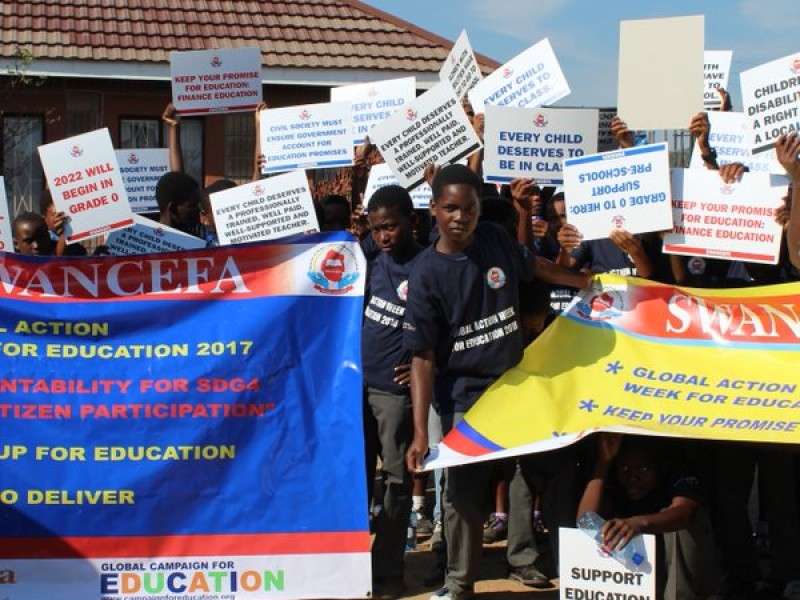ESWATINI Education Coalition Coordinating Agency (CA) Role

ESWATINI Education Coalition Coordinating Agency (CA) Role
The Local Education Group (LEG) is at the centre of monitoring implementation of Education Sector Policies and Education Sector Plans (ESP). It comprises of Government, Development Partners and Civil Society. It is a platform that we as non-state actors utilize to hold those in government accountable for promises made in education. It is also a platform for civil society participation and engagement in policy dialogue. The LEG is the highest decision making body within the Ministry of Education. The composition of the LEG ideally must include: National government including decentralized government representatives and other line agencies such as the Ministry of Finance, Gender and Ministry of Health. Bilateral and Multilateral development agencies and other education development partners such as civil society, private education providers and the corporate sector. Therefore, it is imperative that National Education Coalitions fully participate in this important forum. When this platform is none existent or ineffective, the voice of civil society in education sector processes is weakened.
For the longest time, the LEG was not effective and Eswatini civil society was not involved in education sector and GPE processes. SWANCEFA initiated the conversation with government and UNICEF to become a GPE partner, a conversation that took a number of years, When the conversation started between GPE and government, this stalled due to change in leadership within the Ministry of Education and Training. Subsequently in 2019, the Principal Secretary, the second highest position after the Minister was appointed. This worked in our advantage to start again the conversation. The conversations were started with the support of internal government officials.
Becoming the Coordinating Agency (CA)
In November 2019, a week-long meeting was called by the Ministry of Education and Training where the GPE Education Specialist was also in the country to conduct sensitization on GPE processes including LEG processes, communication with the GPE Secretariat and appointment of the Grant Agent and the Coordinating Agency. In that meeting SWANCEFA was asked make a presentation on the Civil Society Education Fund (CSEF) project. Mostly stakeholders appreciated SWANCEFA’s approach of working with parents, communities and CSOs. It was noted that the Coalition was working with partners who were missing in education processes mainly parents and persons with disability. SWANCEFA was first nominated for the GA position but declined due to its lack of capacity but instead nominated UNICEF. After voting SWANCEFA became the CA and UNICEF the GA.
The Coordinating Agency (CA) Role
The CA is the Chair of the Development Partner Group (DPG). The CA supports the government in leading the LEG. The CA serves as a key communication link between the LEG and the GPE Secretariat. Basically, the CA facilitates the discussion on funding model requirements and coordination of all LEG activities. SWANCEFA as the CA leverages this position for civil society maximum participation in sector and country GPE processes.
SWANCEFA’s experiences as the CA in Eswatini
It is important to understand that mostly this part is about learning as both UNICEF, government and government are new to the partnership. Internally at SWANCEFA we saw an opportunity not just to hold government accountable but also to influence the education agenda in Eswatini and to elevate and amplify the voices of CSO in the education sector. We also saw an opportunity to invite more partners to the local education group. Within the LEG we represent the collective of CSO in LEG processes. This is a huge change from past experiences where decisions were taken without the participation of CSO.
Basically there has been a huge shift of attitude in government. We are no longer perceived as ‘’progressives’’ (word used to describe proponents of change) to a critical stakeholder in education and invited to all important meetings even outside of the local education group. As SWANCEFA we participated in the proposal writing stage for the GPE grant and assumed all responsibility of communicating with the GPE including signing the final proposal document. The office of the LEG Coordinator within the Ministry has been very cooperative and has had frequent consultations with the Coalition.
Challenges
The Coalition is new to GPE processes having joined the CSEF in 2016 and the country in 2019. Learning opportunities are very limited. There are no predecessors to learn and consult from, we depend on the information we research online and other GPE documents.
Administratively, moving around is difficult as we do not have an organization vehicle and staff have to sacrifice their personal vehicles for things to get moving and coordinate. SWANCEFA’s secretariat is very lean with only two program staff. Research and policy development capacity internally is limited. SWANCEFA membership is also not active to make policy submissions but rely on the guidance of the Secretariat.
Achievements
SWANCEFA has been re-elected to the position of CA for the Multiplier Grant (2022-2026). The GA is the World Bank Group. This position will enable the Coalition to to continue playing a critical role of ensuring accountability and inclusion.
SWANCEFA is officially recognized as the representatives of CSO and a critical stakeholder at the highest decision making platform.
Communication has improved (CA as the primary point of communication between the GPE Secretariat and government)
The LEG is now more inclusive and participation promotes transparency as LEG endorses all important decisions including endorsement of the ESP, funding proposals and the CA signs off and communicates same to GPE country focal.
CSO is now able to influence policy and sector plans, for example, the Early Unintended Pregnancy Policy (EUP). SWANCEFA conducted consultation meetings in all the Regions of the country through maximum participation and involvement where stakeholders at grassroots level were reached including parents, learners, traditional leaders and persons with disability.


